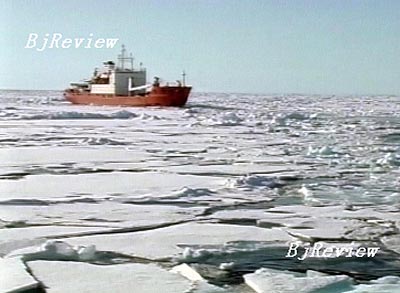
Endless snow, glittering icebergs and polar creatures living in the ocean -- all these bestow a silent beauty on the Arctic. But this beautiful silence was recently broken by a new round of international disputes over the mineral-rich ocean floor around the North Pole.
The rows restarted on August 2 when a Russian submarine expedition planted a rustproof titanium banner on the seabed as a symbol of Moscow's claim to a huge chunk of the Arctic Ocean floor. The Russians believe their country has sovereignty over the region around the North Pole, because one continental shelf connects the Arctic seabed and Siberia.
Big countries, especially the United States and Canada, responded swiftly to Russia's actions. According to a Xinhua News Agency report, a U.S. State Department spokesman said he was not sure if the banner was "a metal flag, a rubber flag or a bed sheet," and promptly dismissed the move as legally groundless. Canadian Foreign Minister Peter MacKay said the voyage was "just a show," and added that Russia could not expect to claim the seabed under a territorial grab more suited to the 15th century.
Nevertheless, the dispute triggered a new round in the Enclosure Movement in the Arctic region. Following Russia's claim, the United States sent its own scientific expedition team to the North Pole, while Moscow said it would send another mission to the North Pole in November.
A hot fight below the ice cover
The eight countries that surround the Arctic -- the United States, Canada, Denmark, Finland, Iceland, Norway, Russia and Sweden -- have had previous clashes over Arctic land ownership in what has come to be called the new Enclosure Movement. The name refers to the original Enclosure Movements in the 18th and 19th centuries in which common land available to the public for grazing animals and growing food was taken and converted to privately owned, enclosed land. This occurred in Britain, the Netherlands and in some places around Northern Europe, as industrialization spread.
In a more recent dispute in 2003, Denmark planted its national flag on Hans Island, an uninhabited Arctic knoll measuring 1.3 square km. The move provoked a disagreement with Canada, which also claims the island.
The recent Russia land grab prompted reactions by several countries. On August 6, the U.S Government dispatched American carriers to the North Pole, while Canada's Prime Minister Stephen Harper announced on August 10 that his country would set up two military bases in the North Pole. Denmark also dispatched a science team to the North Pole on August 12.
In May, Russian President Vladimir Putin had declared that the Lomonosov Ridge, an underwater mountain range in the Arctic Ocean, was a geologic extension of Siberia that Russia could claim under the UN Convention on the Law of the Sea. According to the convention, ocean land can be under one country's sovereignty, if it reaches that country's continental shelf.
Artur Chilingarov, Vice Chairman of the Russian Duma and a polar explorer, led a team of about 100 scientists on the expedition to find evidence of the more than 1,900-km-long mountain range that crosses the polar region. The mission's real goal was to prove the land connection between the North Pole and Russia's continental shelf. By planting its flag in the Arctic seabed, Russia said it reached its goal of the scientific exploration.
But the big question is why now? Observers point to three motives for Russia's claims to sovereignty over the Arctic territory: natural resources, geographic reasons and strategic grounds.
First, Russia wants to get its hands on the abundant oil and natural gas reserves under the North Pole, estimated to be about one quarter of the world's total reserves. Because oil is also a strategic resource, Russia will boost its overall power if it seizes the Arctic territory. The North Pole coal reserves account for 9 percent of world's total reserves, according to Xinhua News Agency. The area under the seabed is also rich in tin, manganese, gold, nickel, lead and platinum. The excavation of these precious mineral resources will bring great wealth to the country that owns the North Pole.
Russia also wants the land for geographic reasons. Due to the greenhouse effect, about 3 percent of the North Pole's ice covers and icebergs are melting annually, and the temperature there has risen 0.5 degrees centigrade every decade during the past 30 years. Experts predicted that it is very possible that a new sea route will appear in about 20 to 50 years. The islands in the North Pole and the Arctic are expected to be livable.
Zhang Zhaozhong, a military expert from the National Defense University of the People's Liberation Army, said that if Russia gets sovereignty over the North Pole, it will have a new land of about 1.2 million square km. The future sea route will connect Russia directly to three continents ---- Asia, Europe and North America, and cut at least 10,000 km from its distance to the United States. This will have enormous economic advantages for Russia, enabling the country to expand its fishing industry and giving it a new sea route to rival the Suez and Panama canals.
| 